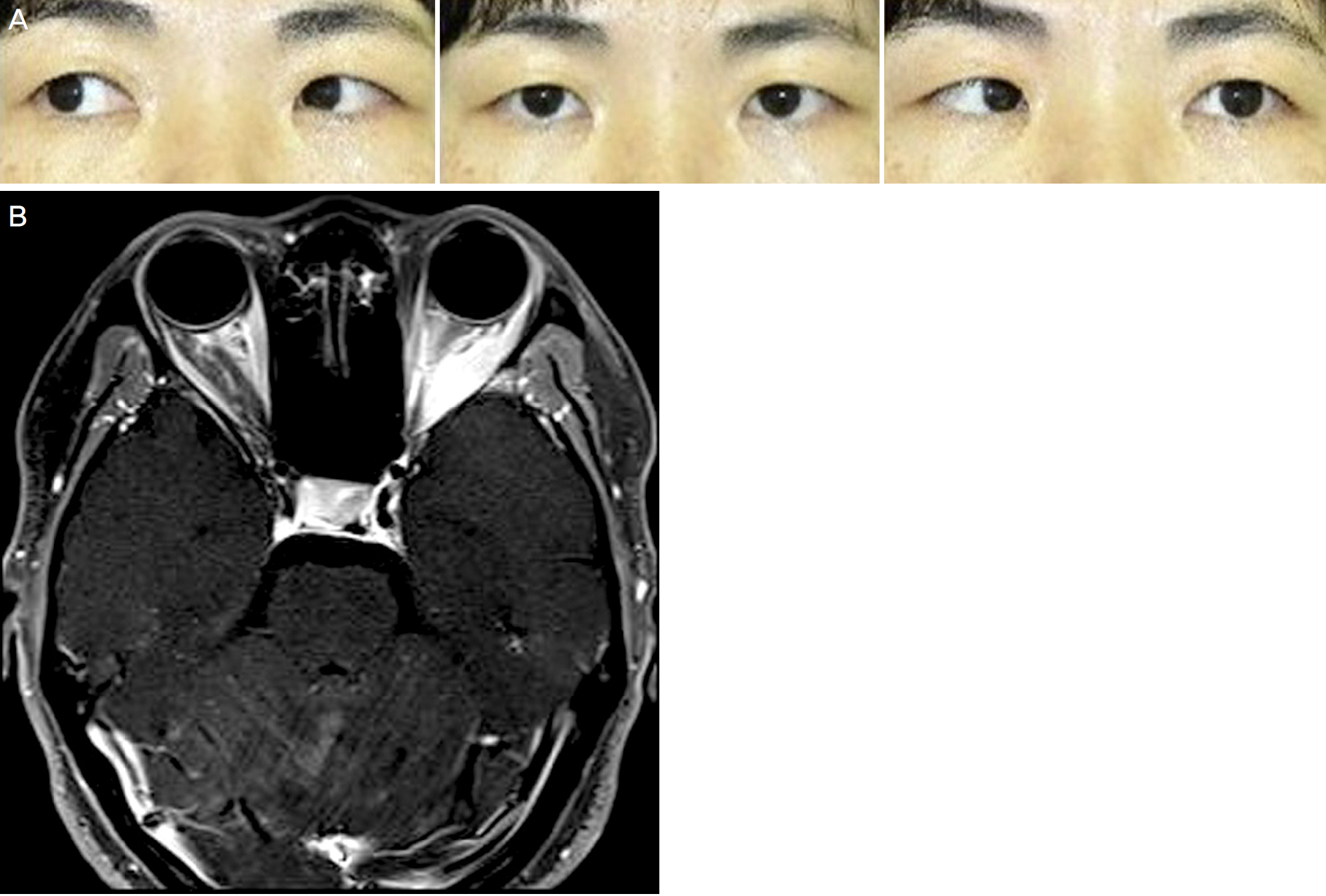J Korean Ophthalmol Soc.
2016 Aug;57(8):1320-1324. 10.3341/jkos.2016.57.8.1320.
Two Cases of Extraocular Muscle Enlargement Caused by Metastatic Cancer
- Affiliations
-
- 1Department of Ophthalmology, Pusan National University Yangsan Hospital, Pusan National University School of Medicine, Yangsan, Korea. jungjaeho@pusan.ac.kr
- KMID: 2349084
- DOI: http://doi.org/10.3341/jkos.2016.57.8.1320
Abstract
- PURPOSE
To report two cases of extraocular muscle enlargement due to malignant cancer metastasis.
CASE SUMMARY
A 56-year-old woman presented with horizontal diplopia first noted 1 month earlier. She had a history of small cell lung cancer with brain and bone metastases. She had a -3 abduction deficit in the right eye and esotropia. The forced duction test showed no limitation in horizontal movement. Antibody tests for thyroid disease showed normal results. Brain magnetic resonance image showed multiple nodular enlargements of the right lateral and medial rectus muscles, al so multiple metastatic nodules in the brain. A 38-year-old woman presented with horizontal diplopia first noted 3 months previously. She had undergone breast cancer surgery 6 months earlier. The patient had a -4 abduction deficit in the left eye and esotropia. The forced duction test showed no limitation in horizontal movement. Antibody tests for thyroid disease showed normal results. Orbital magnetic resonance imaging showed nodular enlargement of left lateral rectus muscle including a tendon.
CONCLUSIONS
Extraocular muscle metastasis is a possible cause of extraocular enlargement and paralytic strabismus. In a patient with malignant cancer, the physician should consider the possibility of extraocular muscle metastasis and perform imaging for early diagnosis and treatment.
Keyword
MeSH Terms
Figure
Reference
-
References
1. Capone A, Slamovits TL. Discrete metastasis of solid tumors to abdominal muscles. Arch Ophthalmol. 1990; 108:237–43.2. Costa RM, Dumitrascu OM, Gordon LK. Orbital myositis: abdominal and management. Curr Allergy Asthma Rep. 2009; 9:316–23.3. Ahmad SM, Esmaeli B. Metastatic tumors of the orbit and ocular adnexa. Curr Opin Ophthalmol. 2007; 18:405–13.
Article4. Goldberg SH, Cantore WA. Tumors of the orbit. Curr Opin Ophthalmol. 1997; 8:51–6.
Article5. Park SY, Kim SY. A case of MALT lymphoma with left inferior rectus muscle invasion. J Korean Ophthalmol Soc. 2014; 55:947–51.
Article6. Shin JH, Lee JH, Lim HK, et al. Bilateral extraocular muscle abdominal of nasal rhabdomyosarcoma mimicking a thyroid associated orbitopathy: a case report. J Korean Soc Magn Reson Med. 2011; 15:176–80.7. Scott AB, Kraft SP. Botulinum toxin injection in the management of lateral rectus paresis. Ophthalmology. 1985; 92:676–83.
Article8. Kim SD, Yang SW, Woo KI, et al. Ophthalmic Plastic and Reconstructive Surgery. 3rd ed.Goyang: Naewae haksool;2015. p. 384–434.9. Char DH, Miller T, Kroll S. Orbital metastases: diagnosis and course. Br J Ophthalmol. 1997; 81:386–90.
Article10. Goldberg RA, Rootman J, Cline RA. Tumors metastatic to the abdominal: a changing picture. Surv Ophthalmol. 1990; 35:1–24.11. Shields JA, Shields CL, Brotman HK, et al. Cancer metastatic to the orbit: the 2000 Robert M. Curts Lecture. Ophthal Plast Reconstr Surg. 2001; 17:346–54.12. Goldberg RA, Rootman J. Clinical characteristics of metastatic abdominalal tumors. Ophthalmology. 1990; 97:620–4.13. Patrinely JR, Osborn AG, Anderson RL, Whiting AS. Computed tomographic features of nonthyroid extraocular muscle enlargement. Ophthalmology. 1989; 96:1038–47.
Article14. Jiang H, Wang Z, Xian J, Ai L. Bilateral multiple extraocular abdominal metastasis from hepatocellular carcinoma. Acta Radiol Short Rep. 2012; 1:pii: arsr.2011.110002.15. Bartalena L, Tanda ML. Clinical practice. Graves' ophthalmopathy. N Engl J Med. 2009; 360:994–1001.16. Yan J, Wu Z, Li Y. The differentiation of idiopathic inflammatory pseudotumor from lymphoid tumors of orbit: analysis of 319 cases. Orbit. 2004; 23:245–54.
Article17. Pakdaman MN, Sepahdari AR, Elkhamary SM. Orbital inflammatory disease: pictorial review and differential diagnosis. World J Radiol. 2014; 28:106–15.
Article
- Full Text Links
- Actions
-
Cited
- CITED
-
- Close
- Share
- Similar articles
-
- Orbital Involvement in Kimura’s Disease Presenting as Diffuse Bilateral Extraocular Muscle Enlargement: A Case Report
- The Measurement of Size of Human Extraocular Muscles and their Changes in Thyroid Associated Ophthalmopathy in Korea
- Effect of Corticosteroid on Orbital Pseudotumor Caused by Orbital Myositis
- Isolated Unilateral Ptosis Caused by Idiopathic Orbital Myositis
- Two Cases of Congenital Fibrosis of the Extraocular Muleles



